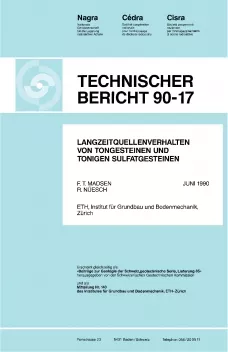
Technischer Bericht NTB 90-17
Langzeitquellenverhalten von Tongesteinen und tonigen Sulfatgesteinen
The swelling behaviour of shales such as the Opalinum Clay, and of clay-containing sulphate rocks is, in addition to the influence of the overburden pressure, mainly dependent on the mineralogical composition of the rock.
The swelling potential of shales increases with increasing content and specific surface area of the clay. Swelling pressures greater than 2 MPa and swelling strains greater than 10 percent are usually not encountered above depths of up to 300 m below the ground surface.
The relationship between the swelling behaviour of clay-sulphate rocks and their mineralogical composition is more complicated than that of pure clays. In those rocks which contain anhydrite, the texture determines the time-swelling behaviour and the development of the mineralogical swelling potential.
Rocks containing only anhydrite do not swell, whereas, rocks containing 5 percent clay may develop a swelling stress of more than 1 MPa for axial strains less than 1 percent. The maximum swelling potential was found in rocks containing 10 to 15 percent clay and 70 to 75 percent anhydrite. With this latter composition, a swelling stress greater than 4 MPa was determined for axial strain less than 2.5 percent. Samples containing more than 15 percent clay tended to show a smaller swelling potential.
The swelling strain of clay-sulphate rock depends on the quantity of anhydrite which is converted into gypsum. The clay content also plays an important role. Rock without clay shows no swelling strain, even after a testing period of six years.
Samples with a higher clay content exhibit a faster conversion of anhydrite into gypsum than do samples with a smaller amount of clay. The swelling strain of samples containing as little as 5 percent clay was more than 100 percent after a testing period of two years. During this period 90 percent of the anhydrite was converted into gypsum.
